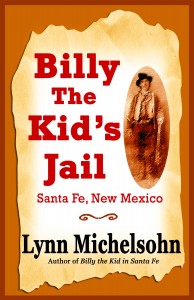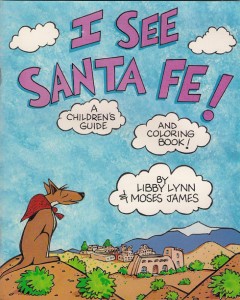Touring “Old Santa Fe”
The world-famous outlaw Billy the Kid spent time in Santa Fe on least two occasions. As a young teen, he lived here with his family for perhaps as long as several years but certainly for the month of February 1873.

Available from these booksellers
What could today’s visitors see an a tour of “Old Santa Fe” that Billy saw during this first stay in New Mexico’s capital?
Although the city looks much the same as it did at that time, thanks to a tourist-oriented movement during the first years of the Twentieth Century to return the “Americanized” town to its earlier “look,” only bits and pieces of original Old Santa Fe remain today. Here are a few of the sights Billy saw that today’s visitors can still enjoy:
Vegetation
When Billy arrived in Santa Fe, low adobe structures lined its dry, dusty streets. Trees were scarce. Native willows and cottonwoods along the Santa Fe River, as well as in some larger arroyos, represented the only naturally green areas for most of the year. They still do today. But the planting and watering that transformed Santa Fe into the shady, green oasis in the high desert we find today had already begun on a small scale when Billy first lived here.
Billy and his contemporaries could enjoy transplanted cottonwoods and pinions growing on the Plaza, however, thanks to Fort Marcy’s Captain Ayers and his beautification efforts during the Civil War. Although none of Captain Ayers’ trees still live today, they have been faithfully replaced with younger specimens of the same species over the years.
Settlers had been cultivating fruit trees, especially apricot and apple, in orchards and courtyards since Spanish days. Late spring brought an explosion of white and pink blossoms then as now.
Catholic Bishop Lamy added French lilacs to the mix in the 1870s. Descendents of his bushes seemingly bloom everywhere throughout the city in late spring. Native cacti, such as cholla, and brush like chamisa with its bright yellow fall flowers, once considered weeds, have become popular landscaping plants.
The Santa Fe River
The Santa Fe River still flows—more or less—through New Mexico’s capital, although it presents a very different picture than the one Billy saw. Successive dams upstream have tamed the once-free-flowing torrent. Spring snowmelt and sudden summer downpours rarely flood the city these days. In fact, a tiny trickle dribbling between muddy puddles often represents its only flow.
Other Waterways
The Acequia Madre, the major irrigation ditch south of the river, still flows along the street of the same name south of the river, just as it did in Billy’s time—and for hundreds of years before that. Indications of once-active smaller acequias remain in places like the Park Avenue area west of Guadalupe Street.
Rushing torrents that still fill the channels Arroyo Mascaras, across Paseo de Peralta from the De Vargas Mall, after summer thunderstorms remind us of the power of the flash floods early inhabitants feared.
City Streets
The layout of nearly all Santa Fe’s main streets, along with most of their names, has remained the same since Billy’s day. In fact, some have not changed since Santa Fe began life as a Spanish colony. Billy would have known San Francisco Street and Washington, Palace, and Lincoln Avenues as the streets bounding the Plaza. None were paved then, of course, and their outward ends extend farther now than they did at that time.
Two major changes have taken place in downtown streets since Billy walked along them. First, an extension now connects Palace Avenue with San Francisco Street at their western ends. (Burro Alley still connects the two closer to the Plaza, but with a substantially changed character.) Second, newly created Paseo de Peralto circles the central commercial area.
Billy would have known today’s roads leaving the city for surrounding communities—Agua Fria Street, Cerillos Road, the Old Taos Highway. All were well established by his time. Modern roads follow the same route along the Santa Fe Trail that first brought Billy and his family into the city. Old Santa Fe Trail still crosses the Santa Fe River in the same spot.
The Plaza Area
The Plaza remains the center of life in Santa Fe and looks much as it did during Billy’s first stay in Santa Fe. Pathways through its greenery still converge on the same Soldiers’ Monument. The Monument itself looks much the same, although it has a few more pockmarks and has lost the word “savage” on its north face. A bandstand to its north still hosts frequent concerts.
Buildings around the Plaza
Although buildings and portales around the Plaza look similar to those of Billy’s day, only two actual structures remain from the time of his first stay in Santa Fe. All others are later additions.
In 1873, the Seligman brothers sold merchandise from their one-story adobe store, still standing on the eastern end of the Plaza’s south side. The building has housed a variety of businesses over the years, most recently a succession of typical tourist shops.
The Palace of the Governors has stood on the north side of the Plaza since 1610 in one form or another. Today it actually looks somewhat more “primitive” than it did in Billy’s day when “modernization” had given portions of its facade a “granite finish” in imitation of cut stone (still visible, preserved beneath Plexiglas under the portal). At that time, square wooden posts supported the portal, and a white Victorian balustrade capped its roof. More recent refurbishing has returned it to an earlier, more tourist-appealing look.
A succession of inns has stood for over 400 years just off the southeast corner of the Plaza. In 1922, the current La Fonda Hotel replaced the very different-looking building that housed the Exchange Hotel of Billy’s time. Inside, today’s La Plazuela Restaurant occupies the original courtyard, now enclosed, that still features the ghost of a distraught gambler who drowned himself there in its well.
Saint Francis Cathedral
The central part of the Cathedral’s front facade, especially the arched stone doorway, is much as Billy would have first seen it, although the building is now complete. Only La Conquistadora Chapel, in the northeast corner of the cathedral, remains from the adobe Paroquia that stood in Billy’s day. Its solid interior walls and its ceiling supported by exposed beams, or vigas, convey an idea of how the rest of the old adobe church would have looked.
Of course, the statue of the Virgin Mary that resides in this chapel is the same one that first arrived in the 1600s. Billy and his family might have seen it carried in procession from this chapel to Rosario Chapel and back if they spent a June in Santa Fe.
Federal Building/U.S. Courthouse (Federal Place)
If you look closely at today’s Federal Building, you can see the difference between rockwork in the lower part—the unfinished proposed Territorial Capitol of Billy’s day—and the upper part, completed later in the century. Only the southern half of the building dates from the 1800s, however; the northern half wasn’t added until the 1930s.
Padre Gallegos House (Washington Avenue)
The popular restaurant Santacafe occupies much of this compound today, with paranoid Padre Gallegos’ indoor well (he feared poisoning of his outdoor well by political enimies), now dry, a feature of its bar.
Hovey House, previously called the Tully House (Griffin Street)
This appears to be a brick house from a distance, much as it did on the day the McCarty-Antrim marriage took place in (a previous incarnation of) the Presbyterian church across the street. The owner had gone to great lengths to make his adobe home look more “American.” Walk up to the porch to convince yourself of its illusion-creating stenciling.
Sena Compound (East Palace Avenue)
With its first section constructed in the late 1700s, this Territorial Style structure looks much the same today as it did in 1873 when Jose Sena and his extended family lived here.
Old Fort Marcy (Kearney Avenue, north of downtown)
The hill supporting remains of this fort, already deserted and serving as a popular picnicking spot in Billy’s day, still provides a beautiful view of the city.
Rosario Chapel and Cemetery (Rosario Boulevard, northwest of downtown)
With its first section completed in the fall of 1807, Rosario Chapel became the permanent replacement for a rustic structure that previously sheltered La Conquistadora—now called Our Lady of Peace—during a novena of masses every June. Don Diego de Vargas and his troops camped on this site during his 1692 reconquest of the city. Every year, a long procession of the faithful carries this statue of the Virgin Mary through the streets of Santa Fe from Saint Francis Cathedral to Rosario Chapel to honor a vow made by de Vargas.
Guadalupe Mission (Guadalupe Street)
Redesigned several times over the years, this original adobe once again looks much as it did in Billy’s day.
Barrio of Analco
Small, closely spaced adobe buildings in today’s East De Vargas Street area give a sense of what much of Santa Fe must have looked like in the 1870s. Many of the structures here, such as the Boyle House, the Crespin House, the Tudesqui House, the Alarid House, and those up Canyon Road including El Zaguan and the Randall Davey House already stood when Billy first came to Santa Fe.
San Miguel Mission, Oldest Church (Old Santa Fe Trail)
Present since the founding of Santa Fe, this mission has undergone numerous reconstructions, modernizations, and restorations since its construction in the early 1600s, although its original adobe walls remain generally intact. Today, its simple look reflects an era even earlier than Billy’s. When Billy first lived in Santa Fe, it may have presented a more ruined appearance than images such as the one in this book suggest, as it had recently been damaged by a ferocious wind storm.
The Oldest House (Old Santa Fe Trail)
Today, this building, with its simple adobe walls and low-ceilinged interior rooms, has been restored to look much as it did in Billy’s day. Walls made of puddled adobe, rather than individual adobe bricks, suggest an origin predating the arrival of the Spanish colonists.
(This is a selection from Lynn Michelsohn’s book, Billy the Kid in Santa Fe, Book One: Young Billy. The book contains much more information about Santa Fe in the 1870s and about those sights from 1873 that remain today, along with facts and fictions about Billy’s first stay in the City Different.)

Available from these booksellers
~

Paperback US $7.95
Available from these booksellers

Paperback US $4.95
Available from these booksellers
You might also enjoy Lynn Michelsohn’s brief book about Santa Fe’s historic jail,
or this children’s guide to the City Different:
Copyright 2004-2014 Cleanan Press, Inc.
